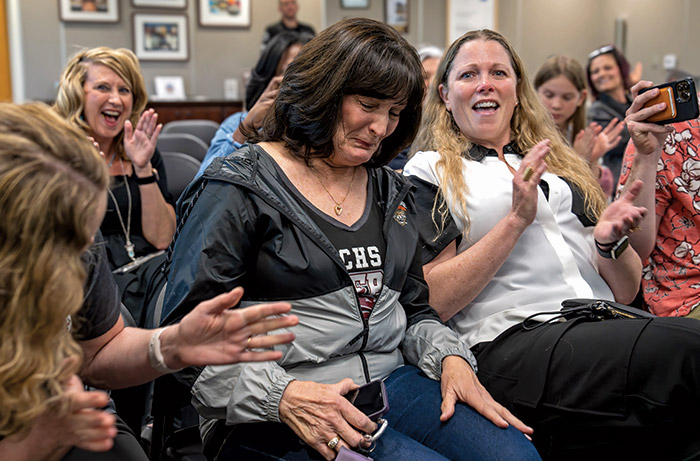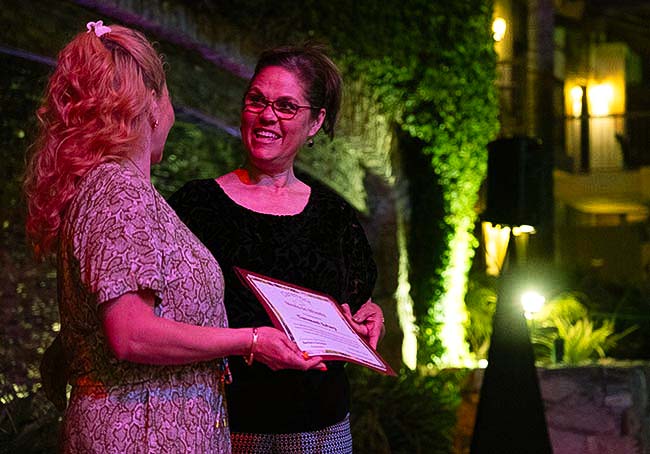Forum draws civic-minded crowd, hopeful candidates
Wednesday night’s school board forum, co-sponsored by the League of Women Voters and the Claremont Educational Foundation, was marked by civility among the candidates and civic engagement among the nearly 100 attendees.
Held at the Hughes Center, the event allowed community members to ask questions of the would-be members of the Claremont Unified School District Board of Education in advance of the Tuesday, November 5 election. All five candidates—incumbent Steven Llanusa and newcomers Dave Nemer, Nancy Treser Osgood, Joe Salas and Paul Steffen—took their place at the dais, hoping to make a good impression as they vie for one of three open spots on the board.
The gathering began with opening statements by the candidates, in which they shared the motivation at the heart of their respective campaigns.
Mr. Salas said his primary aim is ensuring that all decisions made by the board are driven by what is best for students. He acknowledged that his platform includes a number of goals, but added that he considers it crucial for a candidate for any office to bring fresh ideas to the position.
Nancy Treser Osgood feels her background uniquely qualifies her to examine local education at both the micro- and macro-levels. She cited, among other involvements, her experience as a CUSD parent and volunteer, her post as secretary of the Claremont Educational Foundation and her position as chair of the Southwest United States for the Council for the Advancement and Support of Education.
Mr. Llanusa said he is running for the same reason he first ran for the board in 2005. “I think I can make the schools better.” He is pleased with the strides the current school board has made toward goals like academic achievement, fiscal security, safe students, highly qualified staff and an engaged community. Mr. Llanusa said he is also proud that he spearheaded a sixth goal of nurturing the whole child, which he feels serves Claremont students well.
Paul Steffen said being a small business owner in Claremont as well as a longtime resident would help him bring an important perspective to the board. He expressed optimism about the new Common Core form of assessment and associated curriculum, which he believes will give the district the chance to look at methods of instruction with a fresh eye.
“I’d like to assist the board in building on its strengths and overcoming any weaknesses,” Mr. Steffen said.
Like each of the candidates, Mr. Nemer began by thanking the League of Women Voters and the Claremont Educational Foundation, the latter of which recently donated $201,000 to Claremont schools.
“I know CEF can’t endorse candidates, but we all endorse you,” he said.
Mr. Nemer described the first CUSD board meeting he attended, when he first came to Claremont in the early 1970s. Three of five board members voted to close Sycamore Elementary School, a decision that spurred outrage from the community. Soon after, opponents of the closure launched a recall election and the three people who opted for a yes vote were thrown out of office. Seeing that high level of engagement, Mr. Nemer recalls, “I said to myself, ‘That’s quite a community.” Forty years later, he is still in Claremont and still impressed by how much everyone cares about education. He would welcome the opportunity to serve on the school board in such a community.
After the opening statements, the candidates went on to field questions submitted by those in attendance at the forum. These included queries such as “What do you feel is the role of a school board member?” and about how much emphasis the district should place on vocational education opportunities such as those offered through the Career Technical Education programs at Claremont and San Antonio High Schools and at Baldy View ROP.
One question posed is a perennial one raised via letter writers in the COURIER: “What are the benefits and drawbacks of inter-district and intra-district transfers?” Inter-district transfers come from other cities, such as Pomona, while intra-district transfers involve families opting to travel to a Claremont school other than the one to which they are closest.
To a person, the candidates applauded the high level of choice intra-district transfers afford to Claremont families. They also each emphasized that inter-district transfers have provided the school district with a healthy buffer so that classes and schools have not had to be closed while the Claremont population has fluctuated.
“The kids are great,” Mr. Nemer said of the district’s transfer students. “In attendance, discipline and grades, they are indistinguishable from Claremont residents.”
Mr. Salas said the fact that some students travel to Claremont schools from as far as Jurupa, the high desert and San Bernardino is a testament to the excellence of CUSD. As far as intra-district transfers go, he noted that two of the elementary schools in northern Claremont—Condit and Chaparral— have reached full capacity at 646 and 624 students, respectively.
“They can’t grow anymore. There are modulars everywhere,” he said.
Mr. Salas said the district would do well to coax Claremont students to transfer in equal numbers to each school in the district by “improving the perception of quality.” This has been done successfully by Oakmont with its Outdoor School model, which has made it a destination campus, Mr. Salas noted. He feels another way to do this would be to make at least one school, perhaps one in the southern area of the city, have a curriculum that is partially bilingual. It is an idea he says would draw both English learner families and English-fluent kids whose parents would like to see them have a firm foundation in a foreign language.
The candidates had other areas of agreement as well, with all of the candidates giving kudos to the district’s increased focus on “the greening” of schools. Both Mr. Steffen and Mr. Nemer warned it could take a while for the district—along with those in each of the 45 states that have adopted the Common Core—to get the kinks out of the new assessment system. Mr. Llanusa was also cautious, admitting that “we won’t know” what the new testing and curriculum will look like until they are in place.
Nonetheless, Mr. Steffen, Mr. Nemer, Mr. Llanusa and Ms. Treser Osgood each said that they see a strong potential in the Common Core, which will include teaching less standards but will explore those that remain at greater depth.
Mr. Salas, however, sounded a note of warning about the Common Core. It is corporate-driven, he said, and incorporates a top-down approach. President Obama and other Common Core proponents insist the new style of learning and assessment will help US schoolchildren grow into more globally competitive citizens, Mr. Salas said, and yet the Common Core was never benchmarked against exceptionally successful international education systems like those in Finland and Sweden. He also worries there has been insufficient buy-in for the system from teachers.
“Be educated on this issue, please,” he asked.
This school board election is being called especially difficult, because there is a large field of candidates that are each qualified to help govern local schools. Many attendees at the forum were overheard afterwards saying the event was quite helpful in clarifying the issues and delineating the candidates’ views.
Look for COURIER endorsements of school board candidates in the next edition of the newspaper and website on Friday, November 1.
—Sarah Torribio
storribio@claremont-courier.com









0 Comments